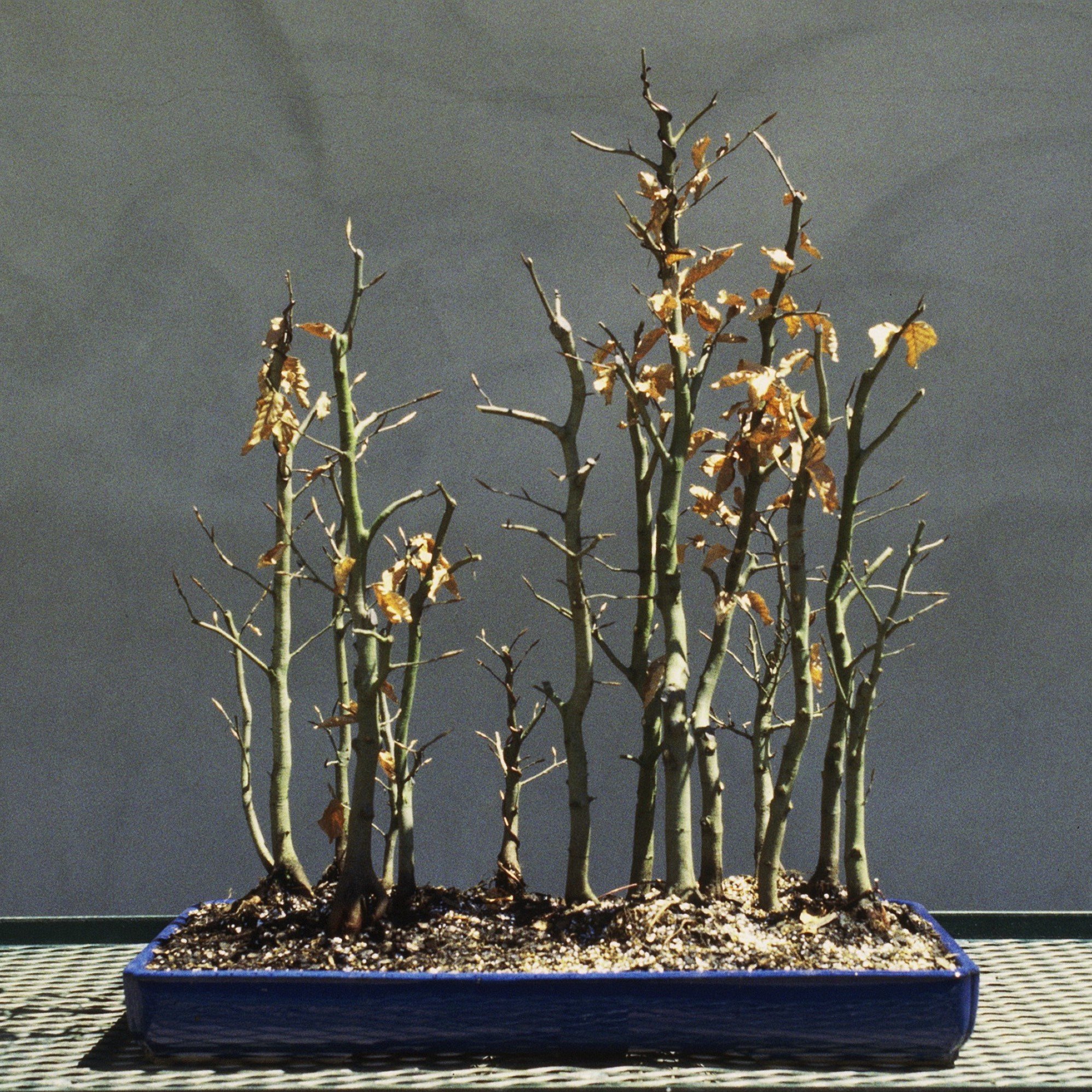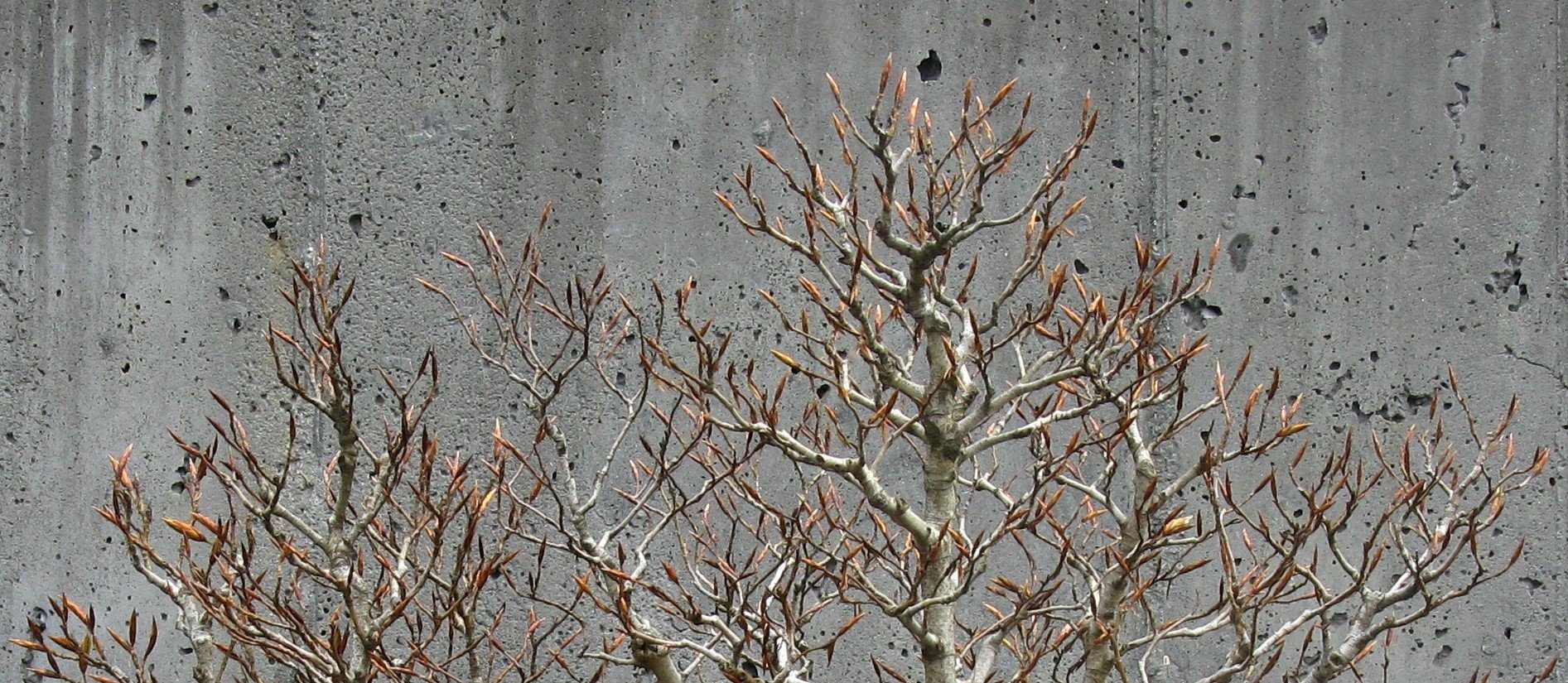The Beech Grove
There is a bonsai that has been part of the Arboretum's collection since 1996, and has been displayed in the bonsai garden nearly every year since the garden opened in 2005. The only times this specimen missed being displayed were a couple of years when mistakes of mine rendered it temporarily unshowable.
The bonsai in question is a group planting of European Beech (Fagus sylvatica). Here is a picture of a garden display from October of 2005, showing the beech grove in the middle:
The beech trees used in this planting were grown from seed at the Arboretum in 1993 as part of the landscape nursery operation. When California bonsai artist Ben Oki visited us in 1996, we gave him some of these very young trees and asked him to make a group arrangement of them. This is what he put together:
1996
If you count trunks, this is a fifteen-tree grouping. However, the two trunks on the far left side of the planting come from a single base, so technically that is one twin-trunk tree, making fourteen trees in all. This only matters because when Ben counted the number of trees after putting the group together, he counted the two-trunk tree as one and that made a total of thirteen. He didn't want a thirteen-tree planting because that number was unlucky. I suggested the two-trunk tree might count as two trees, making it a fourteen-tree group, but Ben wouldn't hear of it. He decided to squeeze one more tree into the arrangement on the far right side to make fourteen, or fifteen if someone wanted to count the two-trunk tree twice.
When looking at the above image, take note of the one tree situated just to the left of center. It is noticeably shorter than any other tree in the group. It is also the tree on which Ben wrapped the most wire, for the purpose of shaping it more precisely because that particular tree was important in his design idea. As Ben saw it, that tree was at a distance from the other trees and farther away from the viewer. This planting was meant to create an illusion of depth, the smallest tree being the equal in height to the others but appearing smaller because it was far away.
I liked the idea of a planting that featured some perspective trickery. The only problem was that the trick never worked for me or anyone else to whom I showed it. Part of the difficulty came from the shape of the container, a long, narrow rectangle. There was an insufficient amount of depth front-to-back for that smallest tree to be positioned in a way that separated it from the other trees. There was not enough physical space with which to work. The tree was meant to be read as small because of distance, but it was right there next to the other trees. It was too easy to notice that the buds and leaves on the little tree were the same size as those on all the other trees around it. It was too easy to see the little tree was little because it was pruned that way, and not for any other reason.
Some ideas work out and some don't. I lived with planting as it was for a few years and then quietly removed the smallest tree. Ironically, that made this a thirteen-tree group once again. Or fourteen, if you count the twin-trunk tree as two.
No photographs exist of the European beech grove for the nine years it spent developing before being featured on display for the opening of the bonsai garden in 2005. After that though, at least one picture was made each year for the next five because the grove was on display and looking good in the garden every year (click on any image for full view):
European beech is a handsome tree, attractive in every season. That was one inducement for having this group of them on display all the time, but another attraction was the bonsai's form. Forest is what this type of arrangement is typically called in bonsai parlance, a planting consisting of numerous trees of the same species. If your concept of a forest is informed by the way the forest is in Western North Carolina, then it is difficult to think of such an arrangement as a forest. The lack of plant diversity suggests this planting is more of a monocultural group or grove, like you would find within a forest, or perhaps a field or pasture. But forests are different in different parts of the world.
Call this type of bonsai what you will, people enjoy them. People enjoy even more a group planting of such a visually striking tree species — with light, smooth bark, elegant leaves that start out a coppery-green, turn full green, then yellow, then coppery-orange in autumn, and prominent, spear-like leaf buds at the ends of bare branches in the winter.
As the beech trees in the grove became larger and more fulsome, gaining ramification and refinement, the container in which they were planted remained the same size and the same commercial-grade quality. It was time for this bonsai to be transplanted to a larger and more distinctive container. The job was done in spring of 2011:
2011
The new container was slab-built by Richard Gualandi, a creative young man who had worked for several years at the Arboretum as a gardener. Richard did pottery as a pastime, but the piece he made for us is well executed, unique in design and has proven durable over a decade of use.
The beech grove did well in its new container, providing the usual beautiful seasonal display over the course of the year:
2011
2011
2011
This image from November of 2012 shows the beech trees in their late autumn glory, partially clad in foliage turning from gold to copper, in harmony with the rich green of the moss and the warm aqua-blue of the pottery glaze:
2012
There is a gap in the photo record of this planting, with no images from 2013 or 2014.
Bonsai trees tend to creep over time, meaning they stretch out and become too tall. It happens right in front of your eyes. It happens slowly, though, in small increments so that you don't notice it until one day you do. To correct this problem requires lowering the height of the tree, but doing so in a manner that doesn't result in it looking like the power company came and topped the tree because branches were getting entangled with electrical wires overhead. To do this, the uppermost line of the trunk is cut back to a secondary branch and then that branch is wired up to carry on as the continuation of the trunk line. That was done to several trees in the beech group in 2013. Unfortunately, the wire was left on longer than it should have been, resulting in bad scarring of the branches that had been wired up. Scarring branches with wire is never good, but it is a disaster for branches featuring smooth bark. The scar may remain visible for the rest of the bonsai's life in such cases. Branch scarring might be hidden when a deciduous bonsai is in leaf, but when the leaves drop in late autumn and the tree is bare for the next five or six months, the scarred branches are there in all their naked ugliness for all the world to see.
I was the one responsible for the wire staying too long on the beech branches. It was a bad mistake and I felt badly about it. There was no fixing that damage except by removal of the scarred branches, which I did, causing the beech group to be taken off display until the affected trees had time to grow new parts. I'd say "live and learn," except it's too soon in the story for me to say that.
The next available image comes from spring of 2015, showing the beech trees bare of leaf:
2015
The tops of several trees have fewer branches, those being the ones that lost the most branching to wire scarring. One tree on the left side of the arrangement has noticeable damage in its top:
That tree needed to be shortened dramatically, to the point where cutting the trunk line so much would leave it looking like it had been done by a human with a saw. The tree had to be shortened, so at the point where it might have been cut with a pruning tool it was broken instead. Not long after putting the beech group back on display, someone asked me what happened to the one tree with the obvious damage in its top. "Was that vandalism?" they asked. "No" I answered, "big wind storm one night."
The rest of 2015 the beech group stayed out on display, going through its customary crowd-pleasing paces (click on either image for full view):
No photographs were made of this bonsai in 2016 or 2017. Great is my embarrassment confessing to you that I made the same mistake I had previously made, and once more damaged numerous branches with wire scarring. You might be incredulous, but I tell you it is much easier to do this than you can imagine. There is no excuse for it all the same, and especially not twice on the same specimen.
When the European beech made it back out on display in the garden in spring of 2018, it looked like this:
2018
Although the means by which the planting came to look the way it does in the above image was completely regrettable, the outcome was actually positive. The heights of the different trees were made to be more varied. That variation created greater visual interest and gave the planting a lighter, more open feeling overall. All the same, I made a promise to myself after this second episode that I would never again put any wire on any tree in the beech grove. Live and learn.
Since returning to the garden in 2018, the beech grove has resumed its place as one of the most constantly on-display bonsai in our collection. In the following selection of images, take particular note of the one from 2020 showing the planting from the opposite side than usual (click on any image for full view):
Here are a set of seasonal portraits from this year:
2023
2023
2023
The next image is a detail of the apex of the largest tree in the grove. In evidence are the stubs of branches intentionally broken off rather than being pruned with a cutting tool. Note, too, the absence of wire scars on the remaining branches!
A detail of the ground plane and the bases of two trees:
As it happened, another European beech from the same seed lot as those in the bonsai beech grove made it into the landscape at the Arboretum. It grows right nearby the lower entrance to the bonsai garden, on the other side of the Grand Garden Promenade:
The most interesting change in the beech grove has taken place in the tops of the trees. Long-term management of the uppermost branch structure of deciduous bonsai trees, especially a group planting of them, is a great challenge. In the gallery below are four detail images showing the upper portion of the planting at various points over a span of twenty-seven years (click on any image for full view):

































